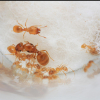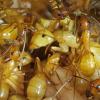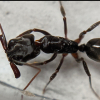I've been back for nearly a month now, and I figured I should probably post an update! The first ants I saw while down in the Keys were lots and lots of Paratrechina longicornis workers, some of which were carrying away the carcass of a Camponotus floridanus major. Along the side of the house was a trail of Tapinoma melanocephalum, who managed to get into the house. While searching around the house, I found a medium sized female Green Iguana who was stuck in a drainage system. I got her out, and after about half an hour of recovering, she ran off and jumped into the canal. The next ants I saw I thought were just very elongated Wasmannia auropunctata, but was later corrected by Alex Wild himself to in fact be Tetramorium similimum. I also saw a few Pheidole navigans workers carrying away a dead fly. I then finally saw those Camponotus floridanus workers drinking nectar from some flowers. Around the front porch, there were some alates from the night before, most of which were dead. I saw a few species, including Pheidole floridana, Brachymyrmex sp., Camponotus tortuganus, and a single male Camponotus planatus. That night there were some massive flights from a few species, Brachymyrmex obscurior, Camponotus floridanus, Camponotus tortuganus, and Pheidole floridana. The next day I went on a nice walk. On that walk the only ants I noticed was a pretty big trail of Tetramorium bicarinatum. I also noticed that on a huge palm tree in my front yard was a trail of Pheidole megacephala. I only saw minors until I started to look through the nest. Near the house I was staying at was a nice little park on the beach. When we first went there, I checked a dying tree on the beach and saw a few Crematogaster obscurata workers. On a nearby tree there was a colony of Technomyrmex difficilis inside of a hollow twig. I also checked a large Sea Grape tree and found a colony of Monomorium floricola inside of a hollow twig. I went to another park later on, one with lots of Red Mangroves! While checking for Cephalotes varians nests, I did see a few Pseudomyrmex elongatus workers scurrying about. There were a few Crematogaster obscurata workers on a different species of tree. On another mangrove tree, I had more luck. I found several nests of Tapinoma litorale and then a nest of Xenomyrmex floridanus, an apparently rare species! A few days later, there were absolutely enormous flights of Brachymyrmex obscurior. They were everywhere! That night there were flights of Dorymyrmex bureni, Paratrechina longicornis, Pheidole floridana, and Tetramorium bicarinatum. The next day I went up to Key Largo. I saw some Cyphomyrmex minutus foraging around the base of a tree. I also saw some more Pseudomyrmex elongatus workers and an alate queen on the side of a building. There were quite a few Cardiocondyla emeryi foraging on a sidewalk. I had also decided to flip over some rocks. Under two of the rocks were freshly flown Odontomachus ruginodis queens! The next day I went to Key West. The first ants I saw was a colony of Solenopsis geminata. While eating I also saw some Tapinoma melanocephalum workers here and there, along with a colony of Pheidole floridana under a rock. I also went to a park which I left very quickly due to a surplus of homeless guys. While I was there though, I happened upon a whole bunch of Pseudomyrmex cubaensis workers at the base of a tree. When I came back to Key Colony, I went back to that one small park. I came across several colonies of Camponotus floridanus, a colony of Technomyrmex difficilis, a few colonies of Xenomyrmex floridanus, a colony of Pheidole dentigula, and a few workers of Tetramorium caldarium. The last day was arguably the most amazing. I was leaving early in the morning. While my family went inside of Starbucks, I stayed outside of the car and looked for ants. I found a large trail of Nylanderia wojciki going up and down a Sea Grape tree. I then saw a dead branch on the same tree with a peculiar mark on the end of it. I cracked it open and some Camponotus workers and males came out. I examined them closer and noticed that they were Camponotus sexguttatus, a species never found in the Keys before! Like everything else, I put the observation on iNaturalist. The next day when I was home, I was messaged by someone on iNaturalist by someone by the name of jim4, saying he was a myrmecologist finishing up a research paper on Camponotus sexguttatus, and was wondering if I wanted a mention. I of course agreed to the offer, and the next day he sent me the paper. And who was this scientist? Oh, no one much, it's just James Wetterer, the first person to sequence ant DNA!!! As a thank you, he sent me a truly amazing book, "Ants of Florida" by Mark Deyrup, which is now my all-time favorite book. He and I have been conversing back and forth, and I am super grateful for the amazing book he sent me. All-in-all, I'd say that my trip to Florida was an amazing success! No Cephalotes, but still incredible to say the least.























